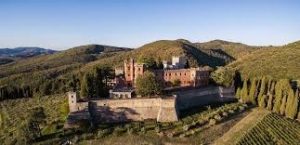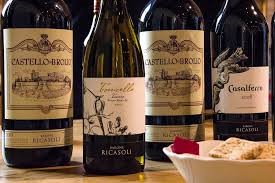This is going to get a little complicated. In the heart of Tuscany’s Chianti Classico region there is a castle named Brolio (https://ricasoli.com/en/). It is owned by the noble Ricasoli family and they make wine there. Some of their wines are named Brolio and others are called Ricasoli and some say both, hence the complication. If you want to visit, go to the town of Gaiole and look for signs pointing to either name.

The Brolio Castle. Photo courtesy of Ricasoli.
Power Tasting is all about going wine tasting and we’ll get to that in a bit. But we can’t overlook the fact that the tasting room is at the foot of a hill and on top of that hill is a castle. It is a major tourist attraction in the region. It is rather grand, with beautiful gardens, and it is available for tours. There is even a restaurant there where you can dine in some splendor. If your wine tasting schedule allows the time, you really ought to see it.
Photo courtesy of Chianti.com
Brolio/Ricasoli makes a lot of wines, some of which are available on store shelves in the United States. The best known, naturally, is their Chianti Classico. [A few words about Chianti, since we’re getting a little complicated. Lots of areas in Tuscany make Chianti but only those in a specified region around the villages of Radda, Greve and Gaiole make the Classico, known for the black rooster (gallo nero) on the label. A Chianti Classico must be at least 75% Sangiovese and up to 10% Canaiolo, with the rest usually filled in with international varietals. Is the Classico any better than any other? Who’s to say? (Well, Lucie thinks so.) But it is marketed way better.]
Brolio’s top wine is the Chianti Classico Gran Selezione, which is rarely available for tasting. However, the Riserva is there and is definitely worth trying. To our tastes, the best part of a tasting at Brolio are the wines generally less associated with their name(s). Among these are their 100% Sangiovese wines, which can’t be called Brunello because they’re not from Montalcino but are made the same way. We particularly liked their Vin Santo dessert wine.
An unusual attraction of wine tasting at Brolio is the stemware used in the tasting room. They are light and beautifully shaped and add an unexpected pleasure to a wine tasting visit. We thought of buying some and bring them home, but they are so thin and fragile, we changed our mind.
Overall, a visit to Brolio/Ricasoli is an event. If there were nothing more than the tasting room and the wines alone, it would be very satisfying. There are the castle, the vineyards, the restaurant, the tours which taken altogether can be a bit overwhelming. We’re not trying to discourage anyone from visiting Brolio – far from it. It’s just that if you want to take full advantage of everything that Brolio has to offer, plan on spending some serious time there.
One thing that Brolio offers is a sunset tour. We have never done it, but the idea of watching the sun go down over the Tuscan countryside is an attraction we might take up on another occasion, and spend the night in the village instead of driving back to wherever we stayed in the past.
